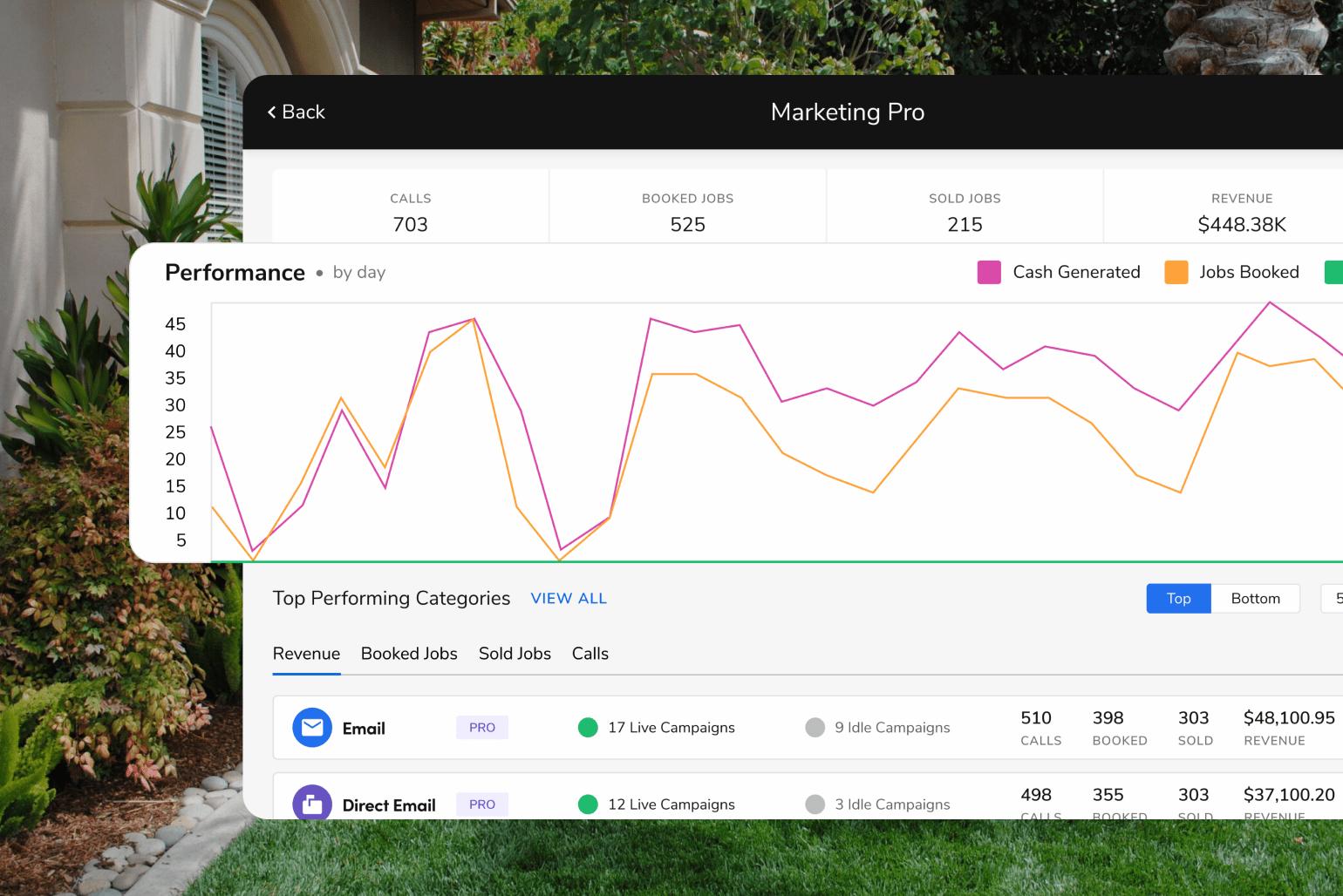How To Build A Social Media Strategy For A Field Service Business

The importance of social media within the context of a marketing plan for a field business is undeniable. Creating a profile and posting random content every so often is not enough to gain traction and drive potential customers to your brand.
A social media strategy encompasses everything from what you want to achieve on your chosen platforms to the tactics you will focus on to meet a set of defined goals.
Before logging onto Facebook or sending a tweet, here’s what you need to know about creating a social media marketing plan.
What Does A Social Media Strategy Entail?
Your social media plan summarizes everything you want to accomplish on social media and how you will do it. When you know how to create a social media strategy, you can establish order and a clear path for tracking a business’s progress on various platforms.
Marketing experts recommend making a social media marketing strategy as specific and detailed as possible to get the most out of it.
Start with a social media strategy template and move from there. A social media marketing strategy is a living document, which means it evolves as your business and customers change.
Why Do You Need a Social Media Strategy?
Crafting a strategy from a social media marketing plan template takes time. Business owners must regularly refer to this document and make changes as necessary.
What are the benefits of embarking on this process?
Generate New Business - The most significant benefit is attracting more business by connecting with a defined target market. More customers mean more profits.
Breed Loyalty - Customer loyalty is the cornerstone of any field service business. Regular clients create a guaranteed income and ensure the future of your brand.
Increase Reach - Localized marketing via social media expands reach and enables growing field service businesses to expand into new towns and neighborhoods.
Perform Market Research - Every successful marketing strategy relies on understanding customers' needs. Social media provides a direct line to your target audience and offers an opportunity to understand their needs.
Make More Money - Social media can become the most profitable marketing channel of any field services business. With more business, a wider reach, and more repeat customers, social media has the power to transform any business.
Forming a strategy for tackling the ultra-competitive social media landscape increases a field service brand’s chances of reporting a positive ROI on its social media investment.
With 57.6% of the world’s population on social media, no business can afford to operate without a strong roadmap for success in place.
How To Create A Social Media Strategy
Anyone can create a plan from scratch or a social media marketing plan template. The basic steps remain the same regardless of your organization’s niche.
Here is a social media strategy example to get you on the right track.
Step One - Choose Your Goals
Social media goals should align with the overall objectives of the business. Remember, a strategy for social media fits within the broader context of a business marketing plan.
Begin by setting SMART goals. All SMART goals have the following in common:
Specific
Measurable
Attainable
Relevant
Timely
General goals like “Get more traffic on Facebook” are useless because there’s no way to draw the line between success and failure. A goal like “Increase Facebook traffic by 50% by the end of Q3” is a great goal because it sets a strict deadline, can be measured and provides a clear threshold for success/failure.
Any social media goal must have a way of being measured through clear metrics. Trim any vanity metrics, as these will not contribute to business success.
Examples of vanity metrics include follower numbers and post likes. They are simple to track, but they have no real value in the context of the customer experience or an organization’s bottom line.
Step Two - Know Your Target Audience
The same strategies and methodologies will not work for everybody. Know your audience through creating audience personas. Once a business has an idea of its target audience, it can tailor its social media content accordingly.
If your lawn care business services the neighborhoods of seniors, the content you post will differ from a pest control organization focusing on large downtown businesses. The goal of social media is always to turn followers into customers.
Critical pieces of information about an organization’s target market include:
Age
Location
Income
Job
Industry
These characteristics only scratch the surface of who your target audience is. Never make assumptions about who your business speaks to and what your market wants to see.
Every decision must come from data. With so many analytical programs and built-in analytics on Facebook, learning about your ideal customer has never been simpler.
Step Three - Learn About The Competition
Lawn care, landscaping, and pest control businesses have bright futures. On the other hand, field services brands operate in a highly competitive industry.
A great social media strategy example is to learn about the competition. The chances are they already have flourishing social media strategies. Target competitors of a similar size and those directly above you.
What are they doing? Which platforms do they use? What sort of content do they post? How often are they uploading new content?
These are the questions you need to answer. Entrepreneurs must avoid the temptation of slipping into a silo. Older, more experienced competitors have already done much of the experimentation for you. If they aren’t doing something, the chances are they are not doing it for a good reason.
Competitive analyses continue throughout your time in business. Things change, and you cannot afford to let your closest competitors get the jump on you.
Conduct some fundamental analysis by looking up your competitors’ social media handles and websites. Keep tabs on them, and stay alert for any substantive changes to their strategies.
Step Four - Perform a Social Media Audit
Now you know what your competitors are doing, it’s time to define your starting point. A social media audit allows marketing teams to ask tough questions and reflect on their current performance.
Ask important questions like:
Which content has the best results?
What isn’t working on social media?
Which social media networks do the competition use?
How does our social media footprint compare to other businesses in my industry?
Carry out social media audits according to a strict schedule. Most field service businesses may choose to produce an audit bi-annually, but others prefer to perform audits every month or every quarter.
The whole point of an audit is to gauge the success of an existing social media strategy and better define the strengths and weak points of a brand’s current footprint.
Step Five - Choose The Right Social Media Channels
Every communication channel must have a defined purpose. Perhaps Twitter will be used to improve the speed of customer support. Maybe Instagram will drive new customers to your website. Or, will Facebook be used to generate more customer loyalty?
You cannot invest in every social media channel. Two or three social media channels are enough to help you create a solid social media plan that works.
Figure out where your customers are, the platforms they spend the most time on, and where your competitors commonly operate.
While expanding into less-common platforms for field services businesses, such as TikTok, may seem tempting, remember to use your time and energy wisely. Every channel must have a clear path to a positive ROI.
Step Six - Select Your Tools
How will you track your metrics, manage your content calendar, and create a sales funnel leading to your website from each social media platform?
Some businesses opt for separate tools, whereas others choose all-in-one solutions to manage their social media marketing strategy, such as FieldRoutes.
Take the time to research the various options, and weigh up the pros and cons of each.
Step Seven - Organize A Content Calendar
Content calendars are a must for tracking holidays and ensuring that any social media plan remains organized.
A content calendar allows businesses to do the following:
Gain reminders for important holidays and boom periods within the field services industry.
Choose optimal times for uploading new content.
Provide a path to automation to save time and keep social media activities efficient.
Track popular hashtags and trends.
Content calendars do so much more than allow automated content uploading. They act as a hub for managing content plans across multiple channels.
Step Eight – Social Media Strategies for Maximum Traction
So far, your plan for social media incorporates a strategy for posting the right content to reach a target audience across the most effective channels.
Maximizing traction requires a multi-pronged approach to success. Factor in more advanced techniques into your plan, along with stated goals, budgets, and monitoring tools.
Some examples of alternative strategies that should form part of your marketing plan include:
Paid Advertising – Facebook ads and boosted posts can elevate your content above all others. Like Google PPC ads, paid advertising requires a tailored strategy for success.
Influencer Marketing – Connect and collaborate with social media influencers to reach a wider audience.
Retargeting – Reach people who have already been exposed to your brand, and target them to get your message across further.
This is simply a social media marketing plan example. You can make your strategy as basic or as complex as you feel necessary. It all depends on what works for you.
Step Nine - Create Your Content Strategy
Social media is all about content. Your content strategy must align with the goals you created earlier in this guide.
A content strategy ensures that:
Content remains aligned with the explicit purpose of the platform.
Other stakeholders have a firm grasp of the content they can expect to see on each platform.
Every network your brand operates on should have a unique flavor. Posting a random blog on Facebook, Twitter, LinkedIn, and everywhere else will not engage your audience.
Instead, you need to think about the purpose of each social media network and the content that best fits that network. Factor in multimedia content, such as images and video to meet the expectations of your target audience.
This is also a time to experiment with different pieces of content. Sometimes you never know when something unexpected will go viral.
Remember, the key to any good strategy is to adopt built-in flexibility. Rigid plans tend to constrain and restrict, which is frustrating for everyone involved.
Step Ten - Analytics
The final step in the process is analytics. State which tools will be used to monitor the metrics of each platform and how often the marketing team will come together to analyze the results.
The analytics process works closely with regular social media audits. However, analyzing results will take place more often than a full audit.
A good rule of thumb is to run analytics at least once per week.
Social Media Strategy Examples
Using a multi-pronged social media plan to reach your target audience will help you get laser-focused on the content you produce and keep it relevant. Also, consider choosing someone to be the face of your brand. People want to know what (who) is behind a brand. You’re more than solely a business—you’re an influencer too, but you have to own the role. It's bigger than the services you offer. It’s about the serving you do. Put effort into making multimedia content, whether it’s pictures, videos, or both. By taking a unique slant on social media marketing, you can set your field service business apart from the rest of the pack. This social media marketing strategy example highlights the benefits one can reap when thinking outside the box.
Tips For A Successful Social Media Marketing Strategy
Creating a strategy is no guarantee of success, but it will enhance your chances.
Success on social media is very much about trial and error. Reduce the investment in trial and error by following these advanced tips for succeeding with your social media plan.
Make Social Media A Team Effort
Companies often make the mistake of allowing a small team of people to manage every facet of social media. While this can allow for a more concentrated effort, it means potentially missing out on great ideas.
Just because someone isn’t a marketer doesn’t mean that they cannot contribute. Talk to the men and women in the field about their thoughts and ideas. Draw from a wide range of backgrounds to perfect your strategy.
Take A Close Look At Your Competition
Many articles talk about taking inspiration from the competition in creating content and targeting the right social media platforms. They encourage you to take the best aspects of the competition and enhance them.
Utilize these great ideas and adapt them to your business. Improve upon them and elicit a transformation that allows your brand to get even better results.
Don’t Be Afraid To Cut
Too many businesses persist with strategies that consistently fail to deliver results. Be ruthless in cutting out parts of your plan that are no longer working.
Is your team too large? Is your business failing to gain traction somewhere? If something isn’t working, swallow your pride and cut it out of your strategy.
It makes no sense to force success on a social media network when people are not biting. Focus your resources on the areas with the greatest chance of success.
Track Customer Reactions
Your customers are the most significant source of data on how you’re doing. Track how your customers react to your brand’s messaging.
As already mentioned, social media strategies are living documents that require regular updates. Use customer reactions to tailor your plan and ensure it’s moving in the right direction.
Factor In The Skunkworks
A skunkworks is a concept initially coined by Google. The idea behind skunkworks is to allow a team to experiment and test out new ideas with no blowback. Google would assign a budget to the skunkworks, and the team can experiment with wacky ideas to see what sticks.
The best social media strategy is not simply following the crowd and hoping for a modicum of success. Landscaping, lawn care, and pest control companies must consistently look for ways to revolutionize their strategies.
Loosen the reins on your team and let them get crazy.
Conclusion
What is a social media plan in a nutshell?
It’s your key to success. It defines everything in simple terms. Anyone who needs to get updated on a field services’ social media tactics only needs to read this document, and they’ll gain a complete breakdown of everything that’s going on.
Now that you know how to approach marketing and social media the right way, let FieldRoutes take care of the rest. Our pest control programs and lawn care software allow you to take control of every aspect of your business, ranging from route optimization to customer retention.
Carve out a niche for your business, and beat the competition with the world’s leading field services cloud platform. To learn more about this platform, schedule your FieldRoutes demo now.





